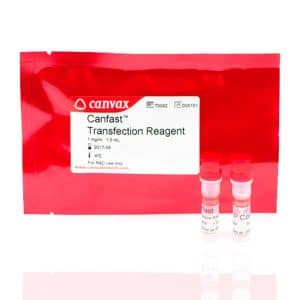Cell Transfection
For a Highly Efficient, Easy & Non-toxic High-Throughput Transfection
Showing the single result
Highly efficient, easy and non-toxic cell transfection solutions
Transfection is the process of delivery foreign DNA into the nucleus of cells. Plasmid DNA, siRNA, mRNA, oligonucleotides, or even Proteins such as Antibodies, may be transfected.
Inside Transfection, Canvax™ offers CANFAST™ Transfection Reagent. It is a new generation of Cationic Polymer with relevant advantages critical for efficient Transfection, such as DNA condensation and endosomal release, which improves gene Transfection Efficiency, delivering a higher stability, reproducibility and resistance, cost-reduction or easy-to-work with.
A solution for every type of Transfection types, methods and strategies
CANFAST™ is widely used for both Primary Cell and established Cell Lines with minimal Cytotoxicity and optimal Transfection Efficiency. It is suitable for transfecting Human Cells as 293-HEK, BOSC 23 and HepG2, Mouse Cells as NIH3T3, P815, B16F10, Rat Cells as RBL2H3, PC12, and Hamster Cells as CHO-K1.
Showing the single result
Highly efficient, easy and non-toxic cell transfection solutions
Transfection is the process of delivery foreign DNA into the nucleus of cells. Plasmid DNA, siRNA, mRNA, oligonucleotides, or even Proteins such as Antibodies, may be transfected.
Inside Transfection, Canvax™ offers CANFAST™ Transfection Reagent. It is a new generation of Cationic Polymer with relevant advantages critical for efficient Transfection, such as DNA condensation and endosomal release, which improves gene Transfection Efficiency, delivering a higher stability, reproducibility and resistance, cost-reduction or easy-to-work with.
A solution for every type of Transfection types, methods and strategies
CANFAST™ is widely used for both Primary Cell and established Cell Lines with minimal Cytotoxicity and optimal Transfection Efficiency. It is suitable for transfecting Human Cells as 293-HEK, BOSC 23 and HepG2, Mouse Cells as NIH3T3, P815, B16F10, Rat Cells as RBL2H3, PC12, and Hamster Cells as CHO-K1.
